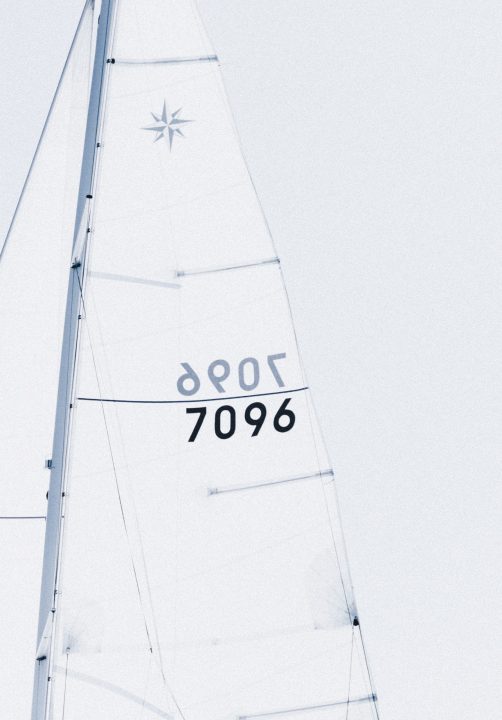Why measure sails? Sailmaking is a complex discipline that blends elements of science and art. Perhaps you want to get a new set of sails made for your older boat, or perhaps you have a new to your boat with no sails to work from. However you attack the problem, you’ll have to start out with some measurements.
Table of Contents
- Sail Measurements and Definitions
- Sailboat Sail Dimensions
- Sails and Sailing Measurements Made Easy
- Sail Dimensions FAQs

Sail Measurements and Definitions
One thing to understand before diving in—sails are three-dimensional objects. You can lay them out flat on the ground, but a perfectly flat sail does not harness the wind. Instead, sails must have a curve built into them, and that makes measuring them much more complex.
The three sides of a triangular sail each have a particular name.
- Leech — The rear edge of a sail that is not attached to anything
- Luff — The forward edge of a sail, attached to the mast on a mainsail or to the stay on a headsail
- Foot — The lower edge of a sail, it runs along the boom on a mainsail
Likewise, each corner of a triangular sail has a name.
- Head — The top of a sail, where the halyard gets attached
- Tack — The forward corner, on a mainsail it gets attached to the gooseneck
- Clew — The aft corner, where the outhaul attaches on a main or the sheets attach to a jib
Sailboat Sail Dimensions
With those basic terms out of the way, it’s time to look at a few things that sailmakers consider when designing a set of sails. The most significant limits placed on the sailmaker come from the boat itself.
Many makes and models of boats have their sail specifications online. It’s essential to break out the tape measure and measure your boat–if only to confirm that the numbers you found are genuine. Remember, at this point, many of our sailboats have had long and storied lives well before we owned them. Your boat may have been custom rigged, and you don’t even know it.
Rig measurements also can change from year to year on one make and model as the manufacturer’s supplier changes. So you can’t be sure which numbers you find on the internet are correct and which apply to a different boat.
Main Sail Dimensions
The limiting dimensions for mainsails are the height of the hoist along the mast and the length of the boom.
- P — distance along the aft face of the mast from the top of the boom (gooseneck) to the point of highest hoist at the maximum main halyard position
- E — distance along the boom from the mast to the maximum outhaul position
Mizzen Mainsail Hoist Elevation and Boom Length
Mizzen mast sails on ketches or yawls will have similar shapes and measurements as a mainsail. Therefore, their P and E measurements are usually denoted Py and Ey to show it is the mizzen sail.

Main and Mizzen Sail Area Calculation
When given P and E, the unknown factor is the length of the sail’s leech. The leech can be longer and curve out, giving the sail more shape and lift by adding roach.
If the sail were perfectly flat, calculating its area would be straightforward. The area of a right triangle is equal to one-half of its two legs multiplied together.
Since the main or mizzen is not a flat object, though, we do not divide it by two (or halve it). Instead, we use a multiplier to estimate its area. For a regular mainsail, divide by 1.8. If the sail has a larger roach, divide by 1.6.
Mainsail Area = (P * E) /1.8
Mainsail Area (heavily roached sails) = (P * E) /1.6
Headsail Dimensions — Jib, Genoa, or Staysail
The key measurements for a headsail are the distance up the mast that you can hoist the sail and the distance from the base of the headstay to the mast.
- I — The height along the front face of the mast from a point level with the headstay pin to the point of maximum hoist
- J — Foretriangle horizontal distance measured from he distance along the main deck, from the tack attachment to the mast
Headsail Area Sail Measurements
Assuming that the headsail is roughly a right triangle, the area equals those two sides multiplied together and divided by two.
Working Jib Area = (I * J) /2
However, it’s important to note that many genoas are designed to overlap the mast. Therefore, using the J measurement does not account for the extra sail area that projects aft of the mast.
135% Genoa Area = (1.44 * I * J) /2
155% Genoa Area = (1.65 * I * J) /2

Luff Perpendicular
In the case of a high-cut jib or genoa that does not form a right triangle, the luff perpendicular measurement is used.
- L — (Luff) The distance of hoist from the attachment of the sail’s tack to the point of the maximum hoist, as measured on the forestay (i.e. the length of the sail’s luff)
- LP — (Luff Perpendicular) The shortest distance from the sail’s clew to the luff
The same area measurement formula applies.
High-cut Jib Area = (L * LP) /2
Sails and Sailing Measurements Made Easy
While it’s fun to work out all the specifications that set one boat apart from another, it’s of little use to the cruising sailor. Measuring sails is a simple task as long as you know what to look for and the limits that your boat places on your sails. Keep in mind that as long as a sail fits, it will probably work. Most sail lofts and second-hand sail dealers work on the “try and see” plan. So hoist the sail and give it a shot—you might be surprised.
Sail Dimensions FAQs
How do you measure a sail?
Sails are measured based on the limitations presented on the boat. For example, a mainsail cannot be hoisted taller than the mast. So a critical measurement for a mainsail is the luff length, denoted by the measurement “P” in sail dimensions. Similarly, you cannot mount a mainsail on a boom that is too short. So the foot of a mainsail is denoted as “E.”
What is sail size?
Sails are sized based on the fixed dimensions from the boat they are made for. In other words, nearly every sail is custom-tailored to the rig on the boat. You can take specific measurements from the rig that will dictate the size of the final sails. Within those boundaries, sailmakers can tinker with a few other ways to add sail area, like adding roach to mainsails or creating overlapping headsails.
How are sail luffs measured?
The luff of a sail determines its draft, or how much curve the sail has. As such, there is no straight-line measurement for the luff of a sail. Instead, sailmakers used the fixed measurements from the leech and foot of the sail to determine its overall size. The luff, in the end, may be curved outward to add roach and more draft.
Too much luff is not a good thing, however. If the luff is too long on a mainsail, the boom may sit too low to clear the bimini, hardtop, or boom gallows.
What is the formula of sail?
The area of a sail is calculated by multiplying the luff or vertical by the foot and dividing by 1.8 for mainsails or 2 for headsails.
Mainsail or Mizzensail Area = (P * E) /1.8
Jib, Genoa, or Staysail Area = (I * J) /2

